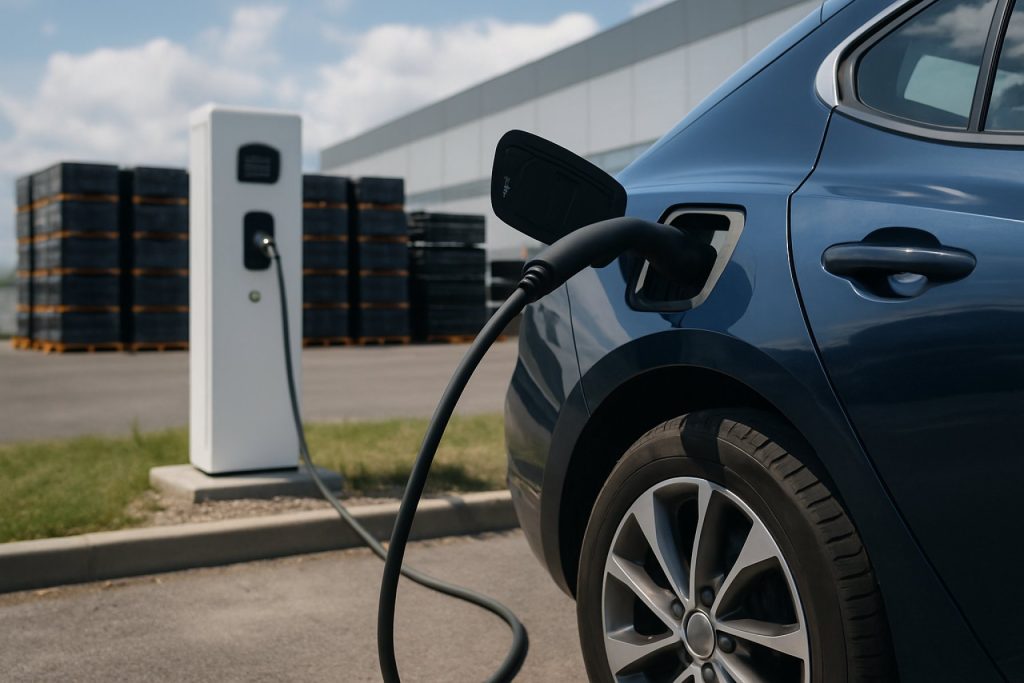
- Global electric vehicle (EV) battery production is projected to triple by 2030, revolutionizing transportation and air quality worldwide.
- The EV battery market is growing rapidly, with a 40% annual growth rate fueled by climate policy, consumer demand, and major investments.
- China leads in EV battery manufacturing, while the US and India are significantly expanding capacity through incentives and new gigafactories.
- Advanced battery technologies like lithium iron phosphate (LFP), nickel-manganese-cobalt (NMC), and emerging solid-state batteries are increasing efficiency, safety, and range.
- Key manufacturers such as CATL, LG Energy Solution, Northvolt, and Samsung SDI are scaling up to meet global EV demand.
- Sustainability improvements include closed-loop recycling systems and a shift toward a circular economy for critical battery materials.
- India is transforming into a leading battery supplier with government support, aiming for affordable, mass-market EV adoption.
Rows of gleaming battery cells, their metallic casings catching the fluorescent light, hum with silent promise inside massive factories. The scale is breathtaking: by 2030, the world is set to churn out enough electric vehicle (EV) battery power to fundamentally reshape how we move, work, and breathe. Global output is projected to triple in just five years, marking a historic turning point in transportation.
The market for EV batteries is accelerating at a breakneck pace. Analysts estimate a stunning 40 percent compound annual growth rate by 2030, a reflection of unstoppable momentum from climate policy, consumer appetite, and historic investment in clean technology. China, already the world’s largest EV market, is expanding production at a pace that dwarfs much of the world. The United States, spurred by federal incentives, and India, driven by relentless urbanization, are undergoing their own battery revolutions.
Gone are the days when lithium-ion was the only game in town. Lithium iron phosphate (LFP) batteries—known for their resilience and low cost—are dominating the portfolios of major automakers, while the evolution of nickel-manganese-cobalt (NMC) chemistry pushes the envelope of possible range and durability. Innovators are on the verge of bringing solid-state batteries to the market—a leap that could slash charging times and banish range anxiety for good. Leading firms such as Toyota and Panasonic, after years of hushed R&D, will soon offer batteries that store up to 50 percent more energy, charge faster, and reduce the risks associated with high-voltage systems.
The industrial giants behind this surge form a globe-spanning web. CATL and LG Energy Solution are set to surpass 500 gigawatt-hours of annual output each—enough to power millions of cars. Northvolt in Sweden and Samsung SDI in South Korea are erecting new gigafactories across Europe and Asia. The US and Indian governments are pouring unprecedented funds into battery innovation, reshaping not just their own transportation landscapes but the world’s.
But growth brings responsibility. The scramble for critical minerals—lithium, cobalt, nickel—has triggered concerns about ethics and sustainability. Yet the industry is pivoting boldly: closed-loop recycling facilities from companies like Umicore and Redwood Materials pull valuable metals from discarded batteries, forging a more circular economy that slashes mining demand and environmental harm.
India’s story is worth watching. The country is evolving from a technology consumer to a regional powerhouse. Homegrown battery factories, supported by ambitious government incentives under the FAME II and Production Linked Incentive (PLI) programs, are poised to turn India into a major global supplier. The hope is that as battery costs fall—already down by more than 80 percent in the past decade—electric vehicles will become everyday machines, not luxury curiosities. The ripple effects on urban air quality and energy independence are difficult to overstate.
The next five years may define our century as surely as the arrival of the internal combustion engine did one hundred years ago. Electric mobility is not just a vision; it’s a global race—and the factories humming across three continents are writing the first lines of this new chapter.
Key takeaway: As EV battery production skyrockets, expect not only more affordable and capable electric vehicles but also a transformed supply chain—from resource extraction to end-of-life recycling—delivering on the promise of cleaner air and a more sustainable future.
For more on the changing world of technology and innovation, visit the official home of Google.
The Future Unplugged: How the EV Battery Boom is Powering a Clean Tech Revolution
EV Battery Industry Facts, Trends, and Game-Changers for 2024 and Beyond
The global electric vehicle (EV) battery market is experiencing explosive growth, reshaping everything from automotive design to the global tech supply chain. Here’s a deeper dive into the untapped dimensions of this transformation—with added details, insider insights, and actionable tips for consumers and investors.
1. Beyond the Gigafactory: Advanced Battery Technologies
While battery gigafactories dominate headlines, the bigger story is in evolving chemistry and innovation:
– Solid-State Batteries are poised to hit mainstream EVs by 2027. These batteries promise higher energy density, faster charging (from 0% to 80% in under 15 minutes), and longer life spans—potentially up to 800,000 km per pack ([Toyota press releases](https://global.toyota)).
– LFP (Lithium Iron Phosphate), with its cost advantages and safety profile, is bringing affordable EVs to emerging markets, especially China and India.
– NMC (Nickel Manganese Cobalt): NMC batteries are sought after for premium EVs due to superior range and performance, though their reliance on cobalt raises sustainability questions.
Pro Tip: When shopping for an EV, check if the model uses LFP, NMC, or—coming soon—solid-state technology. LFP tends to last longer in hot climates, while NMC offers more range [source: BloombergNEF].
2. How-To: Maximize EV Battery Life
Want your EV to go the distance? Try these steps:
1. Avoid Full Charges: Keep battery charge between 20%–80% to extend lifespan.
2. Minimize Fast Charging: Reserve rapid charging for road trips to reduce thermal stress.
3. Maintain Moderate Temperatures: Park in shade; avoid temperature extremes.
4. Regular Software Updates: Automakers issue updates that can enhance efficiency.
3. Real-World Use Cases
– Commercial Fleets: Companies like Amazon and UPS are deploying all-electric delivery trucks powered by high-capacity, fast-charging battery packs, reducing urban emissions significantly.
– Grid Storage: Used EV batteries are repurposed for renewable energy storage solutions, helping stabilize the electrical grid ([Nissan’s xStorage project](https://www.nissan-global.com)).
4. Market Forecasts & Industry Trends
– Global Annual Production: Expected to surpass 3 terawatt-hours (TWh) by 2030, enough for over 40 million EVs per year [International Energy Agency].
– Battery Prices: Projected to drop below $70 per kWh, making EVs price-competitive with gasoline cars, possibly as early as 2026.
– Regional Leaders: China, the US, and India will represent over 80% of new gigafactory capacity by 2030.
5. Reviews & Comparisons
| Battery Type | Pros | Cons | Leading Use Case |
| ————– | ——————————– | ————————- | ———————- |
| LFP | Low cost, safer, long life | Lower energy density | Mass-market EVs (e.g., Tesla Model 3) |
| NMC | High range, compact, lighter | Expensive, cobalt issues | Premium EVs (e.g., Hyundai IONIQ 5) |
| Solid-State | Ultra-fast charging, safe, dense | Not yet mass produced | Next-gen EVs (coming 2027+) |
6. Controversies & Limitations
– Critical Minerals: Mining for lithium, cobalt, and nickel can cause environmental and human-rights concerns. Innovations in recycling and more ethical sourcing are helping, but challenges remain.
– Fire Risks: While rare, battery fires have attracted headlines. Advanced battery management systems and improved chemistries (like LFP and solid-state) are addressing these risks.
– Recycling Bottlenecks: Most batteries today aren’t recycled, but major investments are expanding this capacity rapidly—closed-loop strategies from companies like Redwood Materials are leading the transition.
7. Security & Sustainability
– Green Manufacturing: Factories are increasingly powered by renewables, with companies like Northvolt pledging carbon-neutral battery production.
– Battery Passports: New standards are emerging globally to track every battery’s lifecycle and components, tightening supply chain transparency.
8. Insights & Predictions
– Second-Life Batteries: In five years, “battery as a service” (BaaS) models—where batteries are leased, swapped, and repurposed—will be common, making EVs more affordable and ecofriendly.
– Emerging Markets: India’s localization efforts, supported by government incentives like FAME II and the PLI scheme, are positioning it as a global hub not only for battery assembly but also for innovation and recycling.
9. Most Pressing Reader Questions Answered
Q: Will EVs soon be cheaper than gasoline cars?
A: Yes, as battery costs continue to fall, mass-produced EVs may reach price parity with traditional cars in most markets by 2026-2028.
Q: Are EV batteries safe and reliable for all climates?
A: Newer battery chemistries like LFP perform better in extreme temperatures and are less prone to overheating or fires.
Q: What about disposal and environmental impact?
A: The industry shift toward closed-loop recycling and “urban mining” reduces reliance on raw mineral extraction—especially as battery recycling becomes more efficient and profitable.
10. Actionable Recommendations & Quick Tips
– If buying an EV, check for LFP or upcoming solid-state batteries for longer life and safety.
– Support brands with transparent supply chains and robust recycling commitments.
– Recycle old electronics responsibly—many contain valuable minerals needed for new batteries.
– For investors, monitor companies involved in battery recycling and second-life applications as these are poised for substantial growth.
Final Thoughts: A Revolution in Motion
The electric vehicle battery revolution is not just about cars—it’s about cleaner air, a circular economy, and a reimagined energy future. The race between China, the U.S., and India is driving monumental change. Whether you’re an early adopter, job-seeker, investor, or eco-conscious citizen, understanding these trends will keep you ahead of the curve.
For authoritative updates on technology and innovation, visit Google—your gateway to the shifting world of clean energy.



